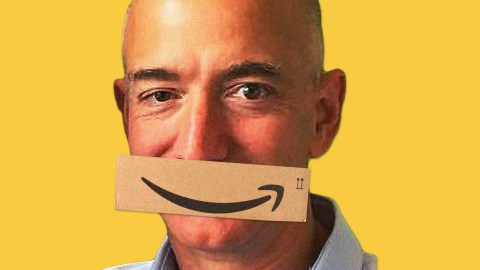How Amazon made $200 billion a year in pure profit

- Jeff Bezos created Amazon to capitalize on growing web usage and e-commerce trends.
- Amazon’s global retail arm brings in the most revenue, but profit is generated by segments like Amazon Web Services (AWS) and third-party seller services.
- AWS sells technologically superior and cost effective cloud computing, while other companies can sell their goods through Amazon in exchange for a fee or commission.
In 1994, a successful but relatively unknown businessman named Jeff Bezos resigned from his position as senior vice-president of the Wall Street-based hedge fund D.E. Shaw & Co. when he learned that World Wide Web usage was growing at a staggering annual rate of 2,300%.
Unlike many of his contemporaries, Bezos was convinced that the internet was more than a passing craze. He started looking for a business plan that would “make sense in the context of that growth.” While driving across the U.S. from New York to Seattle, he drew up a list of 20 products that he thought would be easiest to market and sell online.
This list included discs, computer hardware, software, videos, and books. In the end, Bezos chose to focus on selling books. He made this decision for several reasons. Books are relatively cheap — cheaper than hardware — and they come in great variety. Indeed, there are close to 3 million books written in English alone; far too many to fit inside a brick-and-mortar store. Last but not least, books are (and always have been) in steady demand throughout the world.
That was more than 26 years ago. Today, Amazon sells not only books, but everything from beauty products and clothing to appliances and automotive parts. The company’s selection is so diverse that it has earned the moniker “the everything store.” In addition to its retail branch, Amazon also produces entertainment and cloud computing solutions. But while Bezos has come a long way from his humble origins, his careful planning and forward-thinking attitude remain the keys to his — and Amazon’s — success.
Amazon’s e-commerce
Amazon can be broken down into a number of segments: online stores, third-party seller services, Amazon Web Services, advertising services, subscription services, and physical stores. The online stores or e-commerce segment is not only the oldest, but also the biggest in terms of cash flow.
When Bezos began selling books out of his garage in Washington state, he warned investors that his company would not turn a profit for at least five years of operation. Bezos was right: Amazon reported its first profit in the fourth quarter of 2001, at one cent per share on over a billion dollars in revenue. A CNN financial report from the time said Amazon turned profitable by slashing operating costs and cutting prices for books and music in order to sell higher volumes.
In the fourth quarter of 2021, e-commerce brought in $66.08 billion, or about half of the company’s total revenue. The Amazon website has a larger and more diverse inventory than any brick-and-mortar store ever could. Its layout encourages browsing while its algorithms show products specific to the needs and interests of individual customers, encouraging additional and often unplanned purchases.
Amazon’s sales rose significantly during the COVID-19 pandemic, a time when people were unable or unwilling to enter physical stores. Insider Intelligence predicted that e-commerce sales would continue to rise into 2022, riding a nascent wave of pandemic-driven spending that was sustained through “alternative conversion tactics,” like the Alexa voice assistant and Amazon Live streaming.
This, however, was not the case. In the first quarter of 2022, web sales fell by an unexpected 3%, followed by 4.3% in the next quarter. This trend is not unique to Amazon; other e-commerce giants, from Shopify to eBay, have also reported steady declines. Patrick Brown, VP of growth marketing and insights at Adobe, cites “wavering consumer confidence and a pullback in spending, coupled with oversupply for some retailers” as possible culprits.
Other segments
Even though Amazon’s e-commerce sales have dropped, its revenue and operating income are increasing. This is due, in part, to the steady growth of three other important segments: Amazon Web Services, third-party seller services, and advertising.
Launched as early as 2002, Amazon Web Services — also known as AWS — sells cloud computing platforms. Cloud computing is the practice of using digital servers to manage and process information. The appeal of cloud computing is obvious: Just as a website can offer a larger assortment of items than a brick-and-mortar store, so too can a digital server store larger amounts of data than an actual computer.
AWS makes up only a small portion of Amazon’s total revenue, yet it accounts for an astounding 74% of the company’s total profit. Cloud computing is profitable for two main reasons. Unlike physical products, this fully digital service can be developed and distributed at a minimal cost. More importantly, AWS’ scalability and competitive pricing allowed Amazon to win over clients like Twitter, Facebook, Netflix, and even the U.S. federal government.
Advertising comprises a similarly small part of Amazon’s income (7%), yet it also is growing at an increasing pace. With a revenue of approximately $30 billion per year, advertising on Amazon brings in more money than Snapchat and Twitter combined. The company is also closing in on Google and Facebook, two companies that — up until this point — have ruled the world of digital advertising.
Ads on Amazon come in many different shapes and sizes, some more obvious than others. A prime example are the banners that appear at the top of the screen, showing featured brands. “Sponsored” brands or products show up before non-sponsored brands or products. “Articles related to your search” link to other stores and websites. And Amazon DSP — short for Demand-side Platform — helps businesses target customers off Amazon. Like Google and Facebook, Amazon collects data from customers to customize and personalize their ads: a major selling-point for clients.
Amazon also profits from its third-party seller services. Back when Bezos was working out of his garage in Washington, the company sold only its own items. As Amazon grew bigger, it started allowing other companies to sell on its platform, too. When a third-party sells via Amazon, Amazon takes a cut. The size of this cut varies based on the type of product or service. As of 2022, the average third-party seller was reported to be giving up 34% of its revenue to “the everything store.”
Many third parties let Amazon manage inventory and shipping while they themselves remain responsible for marketing. This service is especially useful for companies that lack the resources and infrastructure needed to store and ship their own products. Businesses can also opt to sell on Amazon Marketplace, where they have to take care of their own logistics and pay a fee instead of commission. According to some observers, Marketplace is Amazon’s most underrated asset.
The future of Amazon
In May 2021, Jeff Bezos announced that he would be stepping down as Amazon’s chief executive officer and assuming the role of executive chairman. Although the founder is no longer as involved with the company as he used to be — his focus is now on his privately owned aerospace manufacturer Blue Origin — Amazon is continuing down a course that he helped set.
Always thinking two steps ahead, Bezos has seized opportunities and circumvented potential crises. Knowing that e-commerce sales would likely drop once the pandemic ended, he diverted resources to the company’s cloud computing and advertising services, which are now bringing in more revenue than ever before. Even as the retail segment stagnates, analysts predict that Amazon’s revenue will double over the next five years.





